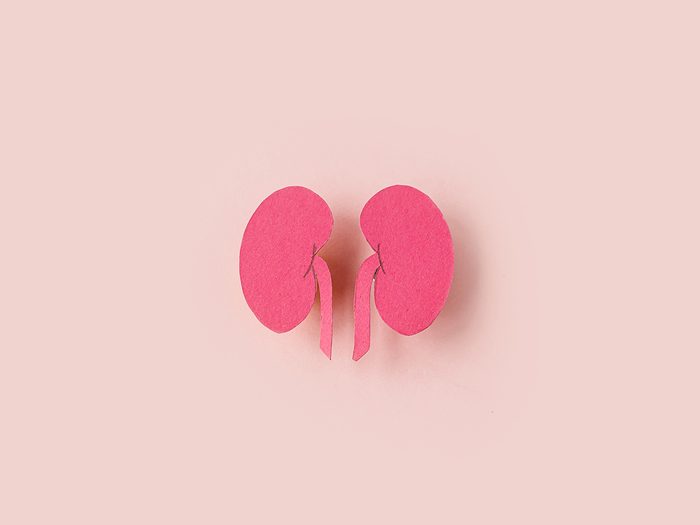Everything You Don’t Know About Kidney Disease (But Should)

One in 10 Canadians has kidney disease––and not all of them know it yet
The kidneys are as vital to our health and well-being as the heart or lungs. But chances are you rarely give them a second thought—or even know how they work. “The kidneys are underappreciated in terms of all that they do,” says Caitlin Hesketh, a nephrologist at the Ottawa Hospital. They filter all of the blood in the body (at a rate of about one litre per minute), balancing minerals like potassium and sodium and removing waste products and excess water through urine. Kidneys also produce hormones that regulate blood pressure and red blood cell production, and they play a role in bone health, since they’re involved in manufacturing vitamin D and managing calcium and phosphate levels. This pair of vital organs, each about the size of a clenched fist, is reddish brown in colour and has a similar shape to its namesake legume, the kidney bean.
When kidneys fail
“There are about 4 million Canadians living with kidney disease,” says Amrita Sukhi, a nephrologist with Trillium Health Partners in Mississauga, Ontario. And many of them aren’t even aware they have renal failure because the symptoms (fatigue, peeing less often) are analogous with other diseases.
The term kidney disease describes an array of disorders and conditions, can range in severity from mild to severe and sometimes results in complete kidney failure (also called end-stage kidney disease). “When people have kidney failure, they may retain too much of that stuff that the kidneys should be getting rid of and that can make people very sick,” says Hesketh. But in the early stages, for the most part, the body compensates well for reduced kidney function. As with high blood pressure, kidney disease can go undetected, and many people only realize they have a problem once it’s quite advanced.
“It’s unfortunate, because people don’t tend to get really sick until the kidney function is down to five or 10 percent,” says Hesketh. Sukki adds, “By the time you get symptoms, which are vague, like poor energy, reduced appetite, some swelling, you can be on the brink of requiring dialysis.” (Dialysis is a medical treatment, often done in hospital several time a week, that cleans the blood and removes waste fluids from the body.) Without treatment, full kidney failure eventually leads to death.
That’s why routine screening for kidney problems is so important. The albumin/creatinine ratio (ACR) test measures the amount of protein in urine, and flags high levels that could indicate possible kidney damage. The estimated glomerular filtration rate (eGFR) blood test is another easy way to measure how well your kidneys are working. Either test can be done as part of a routine exam. Your doctor can determine your risk factors (more on that soon) and how often you should be screened.
Managing kidney disease
“A lot of patients come to the clinic very scared that I’m going to put them on dialysis right away, but it’s possible to live well with kidney disease for many years,” says Sukhi. Most people will require diet and lifestyle modifications, or medications, to manage the effects of their poorly functioning kidneys and prevent conditions like high potassium or low hemoglobin levels. For most people, kidney damage can’t be reversed, but it can be slowed and the effects can be managed.
Most often, kidney disease occurs when a separate condition or disease impairs their function, so treating the underlying cause is also very important, says Hesketh. “If someone has kidney disease due to diabetes, high blood pressure or vascular disease, those patients first treat those issues,” she says. If someone has an underlying infection (like hepatitis B) or an inflammatory condition or autoimmune disease (such as lupus) that is causing their kidney failure, they can take medications to manage that issue, relieving the burden on the kidneys. “Ideally, we do these things to keep the kidney function from getting worse, but inevitably chronic kidney disease will progress over time and eventually some patients may require dialysis or a kidney transplant,” says Hesketh.
For many, a transplant is the only way to get off dialysis—a therapy that can be quite life-altering, says Hesketh. Dialysis treatment can be emotionally draining, a financial burden and an enormous time commitment. Plus, there are the physical side effects, which range from low blood pressure (for patients on hemodialysis) to high blood sugar (for people on peritoneal dialysis). “Patients on dialysis need a tremendous amount of support,” Hesketh says.
Know your risk factors
The risk factors for kidney disease include some you can control, like smoking, and others you can’t. “The most common causes of kidney disease are diabetes and hypertension,” says Sukhi. Diseases of the blood vessels put a lot of pressure on kidney function, which causes damage over time. There are also structural kidney diseases that arise from things like urinary obstructions or hereditary conditions. People of Asian, South Asian, Hispanic and Caribbean descent are at higher risk for kidney disease in general for a variety of reasons. And Indigenous people in Canada are more than three times as likely to have their kidneys fail. People who take non-steroidal anti-inflammatory medications (NSAIDs)—like Celebrex to treat arthritis, for example—may also be at higher risk for this disease.
Supporting the health of your kidneys
For the most part, maintaining well-functioning kidneys comes down to a healthy lifestyle and managing other medical conditions. “If you know there’s a family history of [type 2] diabetes or hypertension that affects the kidneys, know that you should do everything you can to avoid it,” says Sukhi. “You don’t want to wait until you are told you have low kidney function, because at that point they are already damaged.” And, in most cases, that kidney damage can’t be reversed.




